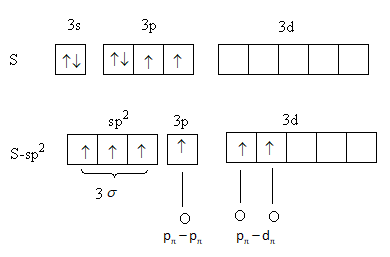
Answer
427.5k+ views
Hint: To determine the answer we should know about hybridization. First we will draw the Lewis structure and by using VSEPR theory we will determine the hybridization to determine the number of sigma and pi bonds. We will also draw the hybridization to determine the orbitals forming sigma and pi bonds.
Complete step-by-step answer:
The sulphur trioxide is known as sulphuric anhydride. The chemical formula of sulphuric anhydride is ${\text{S}}{{\text{O}}_{\text{3}}}$.
We will write the Lewis structure for this we will write the basic structure. Then we will arrange all the valance electrons around each atom to complete the octet. According to valence shell electron pair repulsion theory, the electron pairs get arranged around the central to minimize the repulsion giving a specific geometry. The hybridization and geometry is decided based on the number of sigma and lone pairs around the central atom.
The Lewis structure of ${\text{S}}{{\text{O}}_{\text{3}}}$is as follows:
Total valence electrons are as follows:
$ = \,\left( {6 \times 1} \right) + \left( {6 \times 3} \right)$
$ = \,24$

The sigma electron pairs around the sulphur atom is three. So, the hybridization and geometry of ${\text{S}}{{\text{O}}_{\text{3}}}$is ${\text{s}}{{\text{p}}^{\text{2}}}$ and trigonal planar.
So, sulphuric anhydride has three sigma and three pi bonds.
The hybridization in ${\text{S}}{{\text{O}}_{\text{3}}}$ is shown as follows:

The valence configuration of sulphur is, ${\text{3}}{{\text{s}}^{\text{2}}}{\text{3}}{{\text{p}}^{\text{4}}}{\text{3d}}$ .
The valence configuration of oxygen anhydride is, ${\text{2}}{{\text{s}}^{\text{2}}}{\text{2}}{{\text{p}}^{\text{4}}}$ .
One s and two p-orbitals of sulphur combine to form three ${\text{s}}{{\text{p}}^{\text{2}}}$ hybridised orbitals. Two electrons one form s and one from p-orbital, transfer into d-orbital. Three ${\text{s}}{{\text{p}}^{\text{2}}}$ hybridised orbitals forms three sigma bonds with oxygen atoms. The next p-orbital forms one pi bond. The two d-orbital form two remaining two pi bonds.
So, the types of bonds present in sulphuric anhydride are ${{3\sigma }}$, ${\text{1}}\,{{\text{p}}_{{\pi }}} - {{{p}}_{{\pi }}}$ and ${\text{2}}{{{p}}_{{\pi }}} - {{\text{d}}_{{\pi }}}$.
Therefore, option (B) ${{3\sigma }}$, ${\text{1}}\,{{{p}}_{{\pi }}} - {{\text{p}}_{{\pi }}}$ and ${\text{2}}{{\text{p}}_{{\pi }}} - {{\text{d}}_{{\pi }}}$ is correct.
Note: Hybridised orbitals form sigma bonds only. So, the number of hybridised orbitals are equal to the number of sigma bonds. s-orbital always forms a sigma bond only. The pi bonds are formed by p and d-orbitals. Each atom donates an electron for both sigma and pi bond. Hydride orbits have the same energy.
Complete step-by-step answer:
The sulphur trioxide is known as sulphuric anhydride. The chemical formula of sulphuric anhydride is ${\text{S}}{{\text{O}}_{\text{3}}}$.
We will write the Lewis structure for this we will write the basic structure. Then we will arrange all the valance electrons around each atom to complete the octet. According to valence shell electron pair repulsion theory, the electron pairs get arranged around the central to minimize the repulsion giving a specific geometry. The hybridization and geometry is decided based on the number of sigma and lone pairs around the central atom.
The Lewis structure of ${\text{S}}{{\text{O}}_{\text{3}}}$is as follows:
Total valence electrons are as follows:
$ = \,\left( {6 \times 1} \right) + \left( {6 \times 3} \right)$
$ = \,24$

The sigma electron pairs around the sulphur atom is three. So, the hybridization and geometry of ${\text{S}}{{\text{O}}_{\text{3}}}$is ${\text{s}}{{\text{p}}^{\text{2}}}$ and trigonal planar.
So, sulphuric anhydride has three sigma and three pi bonds.
The hybridization in ${\text{S}}{{\text{O}}_{\text{3}}}$ is shown as follows:

The valence configuration of sulphur is, ${\text{3}}{{\text{s}}^{\text{2}}}{\text{3}}{{\text{p}}^{\text{4}}}{\text{3d}}$ .
The valence configuration of oxygen anhydride is, ${\text{2}}{{\text{s}}^{\text{2}}}{\text{2}}{{\text{p}}^{\text{4}}}$ .
One s and two p-orbitals of sulphur combine to form three ${\text{s}}{{\text{p}}^{\text{2}}}$ hybridised orbitals. Two electrons one form s and one from p-orbital, transfer into d-orbital. Three ${\text{s}}{{\text{p}}^{\text{2}}}$ hybridised orbitals forms three sigma bonds with oxygen atoms. The next p-orbital forms one pi bond. The two d-orbital form two remaining two pi bonds.
So, the types of bonds present in sulphuric anhydride are ${{3\sigma }}$, ${\text{1}}\,{{\text{p}}_{{\pi }}} - {{{p}}_{{\pi }}}$ and ${\text{2}}{{{p}}_{{\pi }}} - {{\text{d}}_{{\pi }}}$.
Therefore, option (B) ${{3\sigma }}$, ${\text{1}}\,{{{p}}_{{\pi }}} - {{\text{p}}_{{\pi }}}$ and ${\text{2}}{{\text{p}}_{{\pi }}} - {{\text{d}}_{{\pi }}}$ is correct.
Note: Hybridised orbitals form sigma bonds only. So, the number of hybridised orbitals are equal to the number of sigma bonds. s-orbital always forms a sigma bond only. The pi bonds are formed by p and d-orbitals. Each atom donates an electron for both sigma and pi bond. Hydride orbits have the same energy.
Recently Updated Pages
Who among the following was the religious guru of class 7 social science CBSE

what is the correct chronological order of the following class 10 social science CBSE

Which of the following was not the actual cause for class 10 social science CBSE

Which of the following statements is not correct A class 10 social science CBSE

Which of the following leaders was not present in the class 10 social science CBSE

Garampani Sanctuary is located at A Diphu Assam B Gangtok class 10 social science CBSE

Trending doubts
A rainbow has circular shape because A The earth is class 11 physics CBSE

Which are the Top 10 Largest Countries of the World?

Fill the blanks with the suitable prepositions 1 The class 9 english CBSE

What was the Metternich system and how did it provide class 11 social science CBSE

How do you graph the function fx 4x class 9 maths CBSE

Give 10 examples for herbs , shrubs , climbers , creepers

The Equation xxx + 2 is Satisfied when x is Equal to Class 10 Maths

What is BLO What is the full form of BLO class 8 social science CBSE

Change the following sentences into negative and interrogative class 10 english CBSE




